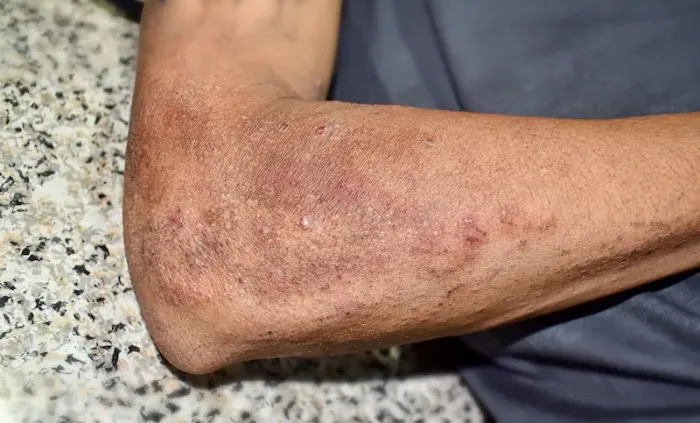Pellagra Understanding Symptoms and Treatment
Pellagra is a nutritional disorder caused by niacin deficiency, leading to symptoms like dermatitis, diarrhea, and dementia. Learn how to recognize the signs early and explore effective treatment options.

Written by Dr. D Bhanu Prakash
Reviewed by Dr. Dhankecha Mayank Dineshbhai MBBS
Last updated on 25th Aug, 2025

Pellagra is a nutritional disorder caused by a deficiency of niacin (vitamin B3) or tryptophan (an amino acid that helps produce niacin). If left untreated, it can lead to serious health complications. The good news is that pellagra is preventable and treatable with the right dietary changes and medical care.
What Is Pellagra?
Pellagra is a condition that occurs when the body doesn’t get enough niacin (vitamin B3) or tryptophan, which is essential for converting food into energy, maintaining healthy skin, and supporting brain function.
Historically, pellagra was common in populations relying heavily on corn (maize) as a staple food, as corn lacks sufficient niacin unless properly treated. Today, it’s rare in developed countries but can still affect people with poor diets, alcohol dependence, or certain medical conditions.
Symptoms of Pellagra
Pellagra is often remembered by the "3 Ds":
1. Dermatitis: Skin rashes, redness, and peeling, especially in sun-exposed areas.
2. Diarrhoea: Digestive issues, including stomach pain and frequent loose stools.
3. Dementia: Confusion, memory loss, irritability, and depression.
Other symptoms may include:
• Fatigue and weakness
• Mouth sores and a swollen tongue
• Headaches and dizziness
• Poor appetite and weight loss
If untreated, pellagra can lead to severe complications, including organ failure and even death.
Consult Top Specialists
What Causes Pellagra?
The main causes include:
1. Poor Diet
• Not eating enough niacin-rich foods (meat, fish, eggs, nuts, whole grains).
• Relying heavily on corn-based diets without proper niacin processing (like lime-treated corn in traditional diets).
2. Alcohol Dependence
• Alcohol interferes with niacin absorption and metabolism.
3. Digestive Disorders
• Conditions like Crohn’s disease, celiac disease, or chronic diarrhoea can prevent proper nutrient absorption.
4. Certain Medications
• Some drugs (like isoniazid for tuberculosis) can interfere with niacin levels.
How Pellagra Affects Health?
Without enough niacin, the body struggles to:
• Produce energy: Leading to fatigue and weakness.
• Repair DNA: Increasing the risk of cell damage.
• Maintain brain function: Causing confusion and mood changes.
• Protect skin health: Resulting in painful rashes and sensitivity.
Long-term deficiency can damage the nervous system, digestive tract, and skin, making early treatment crucial.
Treatment and Prevention
1. Dietary Changes
The best way to prevent and treat pellagra is by eating niacin-rich foods, such as:
• Meat & Fish: Chicken, turkey, salmon, tuna
• Dairy & Eggs: Milk, cheese, eggs
• Nuts & Seeds: Peanuts, sunflower seeds
• Whole Grains: Brown rice, whole wheat, fortified cereals
• Vegetables: Mushrooms, avocados, leafy greens
For those with corn-based diets, soaking or fermenting corn (as in traditional tortilla preparation) helps release niacin.
2. Niacin Supplements
Doctors may prescribe niacin (vitamin B3) supplements in severe cases. Always consult a healthcare provider before taking supplements, as high doses can cause side effects.
3. Treating Underlying Conditions
If pellagra is due to alcoholism or digestive disorders, managing these conditions is essential for recovery.
4. Sun Protection
Since pellagra causes skin sensitivity, wearing sunscreen, protective clothing, and avoiding excessive sun exposure can help prevent worsening rashes.
When to See a Doctor?
If you or someone you know experiences:
• Persistent skin rashes
• Unexplained digestive issues
• Mental confusion or mood changes
It’s important to consult a doctor for proper diagnosis and treatment. Pellagra can be mistaken for other conditions, so a healthcare professional can confirm it through blood tests and recommend the right treatment.
Conclusion
Pellagra is a serious but preventable condition. By eating a balanced diet rich in niacin and addressing underlying health issues, you can avoid this deficiency. If you suspect pellagra, don’t hesitate to seek medical advice—early treatment makes a big difference!
You can consult a doctor online through Apollo 24|7 for personalised guidance. Stay healthy and nourished!
Consult Top Specialists
Consult Top Specialists

Dr. Maharshi Desai
General Physician/ Internal Medicine Specialist
14 Years • MBBS, MD (Int. Med.), FNB (Critical Care)
Ahmedabad
Apollo Hospitals Gandhinagar, Ahmedabad
(50+ Patients)

Dr. Afreen Banu Khan
General Physician/ Internal Medicine Specialist
12 Years • MBBS, DDM (Diab). FCC (Cardio)
Chennai
Apollo Speciality Hospitals OMR, Chennai

Dr Vinay Kumar A V
Nephrologist
8 Years • MBBS, MD - General Medicine, DM - Nephrology
Bilaspur
Apollo Hospitals Seepat Road, Bilaspur

Dr. M. Krishna Bharath Reddy
General Physician/ Internal Medicine Specialist
10 Years • MD General Medicine, MRCP (London) and DM( Critical Care)
Chennai
Apollo Hospitals Greams Road, Chennai

Dr. Neelam Jain
General Physician/ Internal Medicine Specialist
16 Years • "MBBS, DPB ( Dip in pathology and bacteriology)-Mumbai CCEBDM, PGCDM, CCMTD"
Bhopal
Apollo Sage Hospitals, Bhopal
Consult Top Specialists

Dr. Maharshi Desai
General Physician/ Internal Medicine Specialist
14 Years • MBBS, MD (Int. Med.), FNB (Critical Care)
Ahmedabad
Apollo Hospitals Gandhinagar, Ahmedabad
(50+ Patients)

Dr. Afreen Banu Khan
General Physician/ Internal Medicine Specialist
12 Years • MBBS, DDM (Diab). FCC (Cardio)
Chennai
Apollo Speciality Hospitals OMR, Chennai

Dr Vinay Kumar A V
Nephrologist
8 Years • MBBS, MD - General Medicine, DM - Nephrology
Bilaspur
Apollo Hospitals Seepat Road, Bilaspur

Dr. M. Krishna Bharath Reddy
General Physician/ Internal Medicine Specialist
10 Years • MD General Medicine, MRCP (London) and DM( Critical Care)
Chennai
Apollo Hospitals Greams Road, Chennai

Dr. Neelam Jain
General Physician/ Internal Medicine Specialist
16 Years • "MBBS, DPB ( Dip in pathology and bacteriology)-Mumbai CCEBDM, PGCDM, CCMTD"
Bhopal
Apollo Sage Hospitals, Bhopal
.webp)